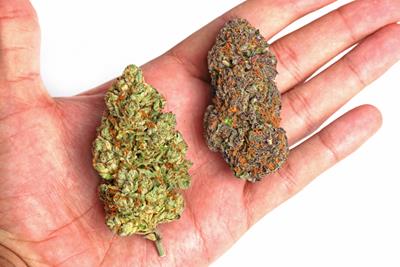
Thursday May 5, 2022
By Trevor Ross
 420 Culture
420 Culture
All the cannabis we smoke, all of the various strains, can be categorized as indica, sativa, or hybrids of the two. These differences are defined by the physical characteristics of the plant as well as the psychotropic effects they have on cannabis consumers. To be clear, indica and sativa are both models of the same make, like different cars made by the same manufacturer. They are both still “weed,” but they handle differently when driven.
Generally speaking, sativas are characterized by higher energy and more cerebral effects, and indicas are characterized by lower energy and more physical effects. However, these differences are not nearly as stark as they used to be. Hybridization – crossbreeding plants together to combine characteristics – compounded with legalization and the increase in growing facilities has led to a deluge of hybridized strains that have come to challenge the old dichotomy of indica vs sativa. That said, it is still possible (and a little fun) to identify what kind of strain you’re smoking, if not the exact strain.
This article reviews the difference between indica, sativa, and hybrid, what makes them different, and tips for identifying each.
How to Identify an Indica
Physical Description

Indicas generally descend from more mountainous landrace strains that adapted to shorter days and colder nights. As such, these strains typically grow in shorter bushes with dense foliage that growers are advised to prune for better ventilation in grow rooms. Indica buds often appear tight and dense in a spectrum dark green to brown colors. Their smell is quite pungent, often described as “earthy,” which could include notes of pine, spice, or skunk.
Characteristic Effects
Indicas tend to produce a more physical “body high” that may result in the inescapable comfort of couchlock. Therapeutically, indicas are often used to relieve pain by both muting pain sensors in the brain and reducing inflammation at the site. Many of these strains serve as general sedatives which can ease an anxious mind or, in higher doses, serve as a sleep-aid.
Recreationally, indicas pair well with long movies and cozy blankets. Going out can be fun too, but many indicas resolve with a decrease in energy. They also have slightly higher amounts of CBD, which may contribute in part to this drowsiness.
Common examples of indica strains include Hindu Kush, Northern Lights, and Grandaddy Purple.
How to Identify a Sativa
Physical Description

Sativas generally descend from tropical landrace strains adapted to long growing hours in hot, humid conditions. For this reason, the plants are generally “leggy,” growing tall and lean, with natural space for cooling breezes to blow through the thin fan leaves.
Sativa buds are usually looser or fluffier than indicas, and may exhibit different pigments including purple and red, thought to help shield the plants from the long hours of direct sunlight in their native climates. Sativa buds also carry lighter scents like lemon, grapefruit, or mild floral notes.
Characteristic Effects
Sativa highs are usually defined as “cerebral” for their potent psychological effects including an almost instant euphoria. Sativa strains are also physically energizing to varying degrees, and so are commonly enjoyed in the morning, even in lieu of a cup of coffee.
Therapeutically, this psychological lift is prescribed to relieve depression and anxiety and, while the kinetic cause remains unclear, some users have also reported relief from ADHD and more manageable focus.

Recreationally, sativas are associated with bursts of care-free creativity perfect for kickstarting projects. That energy and optimism are also great for tackling a day of chores or cleaning around the house. Unfortunately, the racing thoughts associated with these strains can also trigger anxiety in those prone to it, especially at higher doses.
Examples of common sativa strains include Super Lemon Haze, Pineapple Express, and Durban Poison.
How to Identify What You’re Smoking
As stated previously, the line between indica and sativa is blurring with the explosive increase in hybrids. While this makes for some great new strains, it can also make identifying specific strains much more difficult. However, because the original characteristics of an indica or sativa are so prominent, it is at least possible to determine what characteristics are present in your bud. In general, identifying an individual strain of weed will come down to three key things: the look of the weed, the taste of the bud and the feel of the high.
How does it look?
Looking at your biggest, most attractive bud, what do you notice? Is it bright green or does it have hints of other colors as well? Is it dense or is it fluffy? Are the buds large or small? Knowing this can help you determine whether you’re smoking an indica, sativa or a hybrid of the two. That’s because indicas and sativas exhibit different growth patterns based on their area of origin.
How does it taste?

Though strain attributes vary greatly, even within the same genetic line, they will often be named after characteristic flavors. For instance, diesel strains have a gasoline flavor just as lemon strains will exhibit a lemon flavor. If you can’t know whether your bud is an indica or sativa, pulling out characteristic flavors will allow you to narrow down your options. Keep in mind that kush strains tend to lean indica while haze strains tend to be sativa. Skunks are often sativa-dominant hybrids.
How does it feel?
Thanks to the countless strain reviews online today, it’s easier than ever to plug a few keywords into a search engine to find strains that match your high. Whether you find yourself nodding off, lost in thought, or chatting up a storm after smoking, there’s likely a reviewer who thought the same thing. To find out for sure, just search for strains that create the high you’re experiencing while keeping in mind what you’ve already discovered about your bud.
Conclusion

One factor not addressed much here is the growing environment. Even similar phenotypes grown in different environments can turn out as differently as children raised in different homes. So Girl Scout Cookies grown in hydroponics may look and even feel a little differently than Girl Scout Cookies grown outside in the wind and sun, but the taste and smell will not change much.
Knowing the scents, flavors, and physical appearance of your favorite strains will help you communicate with friends, medical professionals, or budtenders when looking for similar options.
Fifty years ago it was far easier to identify your weed strictly by scanning or smelling it. Relentless hybridization has made that more difficult, but knowing the fundamental characteristics of these types of strains is still useful for finding your favorite strain. Next time you smoke something you love, make a note of how it looked, smelled, tasted, and felt.
Frequently Asked Questions
How Do You Know What Strain You’re Smoking Is?
Strains can be identified by some combination of look, smell, taste, and effect. Sativas tend to have fluffier buds with sour or citrusy odors. They may taste like lemon or pine, and offer strong cerebral effects. Conversely, indicas usually have tighter, denser buds that smell like earth, compost, or skunk. Some may even taste like skunk, though others can be as sweet as berries. Indicas are far more sedative, which is why they are often used as a sleep aid.
Can People Tell The Difference Between Sativa and Indica?
Yes. While most contemporary strains are hybrids, many indica and sativa traits can still be seen, smelled, and felt in the effects of a given strain.
What Happens If You Smoke Both Indica and Sativa?
You will get high. The effects of combining strains are not much different than smoking a hybrid strain, which will exhibit some combination of cerebral and physical effects.
How Does Sativa, Indica, and Hybrid Make You Feel?
Sativas tend to be physically invigorating with a cerebral euphoria. Indicas tend to be more sedative, and are used therapeutically for pain relief and as a sleep aid. Hybrids offer results from the spectrum of cerebral and physical effects, to varying degrees.
How do you tell the difference between indica, sativa, and hybrid? Tell us in the comments below!
Photo Credit: Shutterstock







